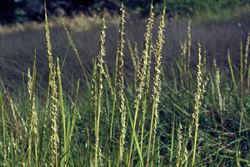Click on images to enlarge

upright seed-heads (Photo: Trevor James)
Scientific Name
Spartina anglica C.E. Hubb.
Synonyms
Spartina townsendii H. Groves & J. Groves (misapplied)
Family
Gramineae (South Australia)Poaceae (Queensland, New South Wales, the ACT, Victoria, Tasmania, Western Australia and the Northern Territory)
Common Names
common cord-grass, common cordgrass, cord-grass, English cord-grass, English cordgrass, rice grass, ricegrass, salt marsh-grass
Origin
This species is thought to have emerged shortly after smooth cordgrass (Spartina alterniflora) was accidentally introduced into Great Britain from North America in ship ballast water. Smooth cordgrass (Spartina alterniflora) is thought to have crossed with the native small cordgrass (Spartina maritima), resulting in the appearance of the sterile hybrid known as Townsend's cordgrass (Spartina x townsendii). It is then believed that further crossing resulted in the development of common cordgrass (Spartina anglica), which produces fertile seed.
Cultivation
This species has been deliberately planted in coastal estuaries for the stabilisation of tidal mudflats and their conversion into useful pasture.
Naturalised Distribution
Common cordgrass (Spartina anglica) is naturalised in the coastal districts of south-eastern Australia (i.e. Tasmania and southern Victoria).
Also naturalised elsewhere in western Europe (e.g. Ireland, France, Denmark, Germany and the Netherlands), and in New Zealand, western North America (i.e. California, Washington and western Canada) and temperate Asia.
Habitat
In the UK and other parts of Europe, common cordgrass (Spartina anglica) grows on mud-flats and in salt marshes near the high tide mark. It is a weed of similar habitats in the temperate regions of Australia (i.e. salt marshes, estuarine wetlands, shorelines, etc.).
Habit
A deep-rooting, long-lived (i.e. perennial), grass growing 30-130 cm tall. It spreads by fleshy creeping underground stems (i.e. rhizomes) and forms large clumps.
Distinguishing Features
- a long-lived grass spreading by fleshy creeping underground stems and growing 30-130 cm tall.
- its upright flowering stems are relatively stout (about 5mm thick) and usually hollow.
- its green or greyish-green leaves (10-45 cm long) are long and narrow with flat or inrolled margins.
- its seed-heads (12-40 cm long) have several contracted branches and end in a bristle up to 5 cm long.
- its elongated flower spikelets (14-21 mm long) are borne in two rows along one side of the seed-head branches.
Stems and Leaves
The upright flowering stems (i.e. erect culms) are relatively stout (about 5mm thick) and hairless (i.e. glabrous). They are round, smooth and usually hollow.
The green or greyish-green leaves consist of a leaf sheath, which partially encloses the stem, and a spreading leaf blade. These leaves are clustered at the base of the plant and alternately arranged along the stems. The overlapping leaf sheaths and the elongated (i.e. linear) leaf blades are hairless (i.e. glabrous). These leaf blades (10-45 cm long and 6-15 mm wide) are flat or inrolled upwards, with entire margins and pointed tips (i.e. acute apices). Where the leaf sheath meets the leaf blade there is a dense line of hairs (i.e. ciliate ligule) 2-3 mm long.
Flowers and Fruit
The seed-heads (12-40 cm long) have several (2-12) contracted branches and are borne at the tips of the flowering stems (i.e. they are terminal panicles). The main stem of the seed-head (i.e. rachis) is somewhat three-angled and ends in a bristle up to 5 cm long. Each of the upright (i.e. erect) or slightly spreading branches is up to 25 cm long. Numerous closely-overlapping, stalkless (i.e. sessile), flower spikelets are borne in two rows along one side of the seed-head branches. The narrowly oblong flower spikelets (13-21 mm long and 2.5-3 mm wide) are flattened and tightly held (i.e. appressed) to the branches. Each of these flower spikelets consists of a pair of bracts (i.e. glumes) and one, or rarely two, tiny flowers (i.e. florets). Each of the florets has an inner and outer floral bract (i.e. palea and lemma), three large stamens with anthers 8-13 mm long, and an ovary topped with a feathery two-branched stigma.
These flower spikelets fall from the seed-heads intact when mature. They contain the 'seed' (i.e. grain or caryopsis) enclosed in the other flower parts (i.e. lemma, palea and glumes).
Reproduction and Dispersal
Common cordgrass (Spartina anglica) reproduces via seeds and creeping underground stems (i.e. rhizomes).
The creeping underground stems (i.e. rhizomes) enable colonies to spread laterally and cover large areas. Seeds and rhizome fragments can be dispersed by ocean currents, wind, ships (i.e. in ballast water), humans, or on the feet waterfowl. Drifting common cordgrass (Spartina anglica) seeds are known to remain viable for several weeks in sea water.
Environmental Impact
Common cordgrass (Spartina anglica) is regarded as an environmental weed in Victoria and Tasmania. It was recently listed as a priority environmental weed in at least one Natural Resource Management region.
Legislation
This species is declared under legislation in the following states and territories:
- Victoria: F - a statewide noxious aquatic species. This plant poses a serious threat to fisheries, the aquatic environment or human health. It is an offence to bring this plant into Victoria or possess, sell transport or release it.
- Western Australia: Prohibited - on the prohibited species list and not permitted entry into the state.
Management
For information on the management of this species see the following resources:
- the Tasmanian Department of Primary Industries and Water management strategy on this species, which is available online at http://www.dpiw.tas.gov.au.
Similar Species
Common cordgrass (Spartina anglica) is very similar to Townsend's cordgrass (Spartina x townsendii), and often grows in the same areas. These to plants can be distinguished from each other by the following differences:
- common cordgrass (Spartina anglica) has a fringe of hairs (i.e. ciliate ligule) 2-3 mm long where the leaf sheath meets the leaf blade. The anthers on its stamens are relatively large (8-13 mm long).
- Townsend's cordgrass (Spartina x townsendii) has a fringe of hairs (i.e. ciliate ligule) 0.2-2 mm long where the leaf sheath meets the leaf blade. The anthers on its stamens are relatively small (4-8 mm long).

